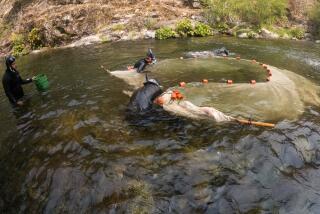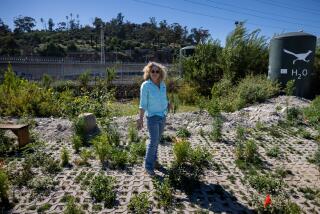Cleanup Makes It a Source of National Pride : Seoul’s Once-Dead Han River Brought Back to Life
- Share via
SEOUL, South Korea — The Han River, once so fouled by industry and sewage that dead fish lined its banks, has come alive again with carp, catfish and waterfowl.
“It used to be so dirty, you couldn’t catch any fish, and you never saw ducks or sea gulls like now,” said Mun Hong Gu, a seafarer who has known the river for 40 years.
A five-year engineering project has unclogged and cleansed Seoul’s lifeline, transforming the Han into a source of national pride.
Cleanup Began in 1982
The river fell victim to rapid industrialization as textile mills, chocolate factories and city sewer systems poured waste into its waters. In 1982, the government launched a $470-million project both to clean the Han and provide a sorely needed face lift for this city of nearly 10 million before it hosts the 1988 Summer Olympics.
“The Han is like clothing to the people of Seoul--something to wear daily with pride, something to keep clean,” said Kim In Sik, director general of Seoul’s Water Supply Bureau, which oversees the work. “Our fathers and their fathers would swim in it. It’s our lifeblood.”
For centuries Korean merchants plied the Han, which winds 293 miles through the central Korean peninsula before reaching Seoul and emptying into the Yellow Sea. Farmers raised cabbage and potatoes on its banks, and scholars gathered at riverside pavilions to study Confucian scriptures.
Barrier Against Invaders
The Han also afforded a buffer against marauding Mongolians in the 13th Century, a Japanese invasion in 1593 and Communist troops during the 1950-53 Korean War.
The renewal project covers a 23-mile stretch of metropolitan Seoul.
Three of the project’s four stages are complete: a new highway, four sewage treatment plants and dredging to control water levels and flooding. The final phase, building recreational areas and terracing the banks, is expected to be finished by the end of the year.
New Land Created
Engineers have created 1,730 acres of land along the shore, built with material dredged from the river.
“We use about 90% of the sand and pebbles from dredging for construction,” said city planner Park Kyei Byung. He said sales of the dredged material paid for nearly half the project’s total cost.
The riverbed was irregular and too shallow to navigate at many points, so workers scooped out the marshlands, sand bars and nearly all the islets in the river in 1982. Today the Han averages about a half-mile in width and is eight feet deep.
On the south bank a four-lane highway from Seoul’s airport to the riverside Olympic site at Chamsil was increased to eight lanes, helping build up the south bank as a business-residential district. The pollution control plants daily treat 107 million cubic feet of sewage--much of it coming from upstream.
Biochemical oxygen demand, a pollution yardstick indicating the density of oxygen-consuming microbes, has dropped from 7 to 9 parts per million five years ago to about 3 ppm, thanks mainly to tightened control over waste emissions, Kim said. Anglers also can catch such delicacies as loach and eel from the Han.
Place for Lovers Once
Kim remembers when he and other young lovers strolled along the Han’s banks. “It was romantic then, but we haven’t seen any of that in recent years.”
Seafarer Mun is elated at the return of deep emerald water and migratory birds.
“They come to nest here because there’s food for them,” he said, standing on the deck of a ferry. “It’s so moving to see the beauty that has returned to the Han.”
Work continues on terraced banking for flood control and recreation areas. Cranes hover over huge mounds of gravel while crews build vast sports grounds.
Pleasure boats also cruise the Han, carrying about 3,500 people a day.
“We thought of operating pleasure boats 10 years ago,” said Joung Chung Ryol, business manager of Semo Co., which began the service six months ago. “But with the river so unattractive, the idea never got anywhere.”
Now leisure firms are developing windsurfing and water skiing.
Seventeen local contractors took part in the redevelopment.
“It’s an all-Korean project,” Park said. “All aspects involve Korean firms and equipment, except for one bridge-building device from Switzerland.”
“It wasn’t necessary to seek even consulting from abroad,” Kim said. “People who know every bit of the river can do the best job. And no one knows this river better than Koreans.”
More to Read
Sign up for Essential California
The most important California stories and recommendations in your inbox every morning.
You may occasionally receive promotional content from the Los Angeles Times.










